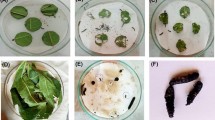Abstract
Bioassay-guided isolation of bioactive natural substances requires monitoring of all fractionation and purification steps using a bioassay system. This is often a long and tedious process, especially with insect feeding bioassays. We report here a new method, based on the principle of bioautography, for a quick isolation of insect antifeedant compounds. TLC plates, after development, are coated with a thin layer of artificial diet and fed toSpodoptera litura larvae. The location of uneaten areas is then compared with theR fvalues of the TLC spots, in order to determine rapidly the active fractions. This methods allows for a very fast determination of the most active antifeedant compounds in a complex mixture and considerably speeds up the isolation process. This new method was successfully applied in the study of antifeedant activity of several plant samples, and results are presented here for a model plant,Skimmia japonica (Rutaceae). Using this new method, the compounds responsible for the feeding-deterrent activity, three furanocoumarins (bergapten, xanthotoxin, and oxypeucedanin), were quickly and efficiently identified.
Similar content being viewed by others
References
Alkofahi, A.,Rupprecht, J.K.,Anderson, J.E.,McLaughlin, J.L.,Mikolajczak, K.L., andScott, B.A. 1989. Search for new pesticides from higher plants, pp. 25–43,in J.T. Arnason, B.J.R. Philogène, and P. Morand (eds.). Insecticides of Plant Origin. ACS Symposium Series 387, Washington, D.C.
Atkinson, E., Boyd, D.R., andGrundon, M.F., 1974. Coumarins ofSkimmia japonica.Phytochemistry 13:853–855.
Escoubas, P.,Lajide, L., andMizutani, J., 1992. An improved leaf-disk antifeedant bioassay and its application for the screening of hokkaido plants.Entomol. Exp. et Appl. In press.
Feeny, P. 1976. Plant apparency and chemical defense.Recent Adv. Phytochem. 10:1–40.
Ferguson, J.E., Metcalf, E.R., Metcalf, R.L., andRhodes, A.M. 1983. Influence of cucurbitacin content in cotyledons of Cucurbitaceae cultivars upon feeding behavior ofDiabroticina beetles (Coleoptera Chrysomelidae).J. Entomol. Soc. Am. 76:47–51.
Hamburger, M.O., andCordell, G.A. 1987. A direct bioautographic TLC assay for compounds possessing antibacterial activity.J. Nat. Prod. 50:19–22.
Harborne, J.B. 1984. Phytochemical Methods. A Guide to Modern Techniques of Plant Analysis. Chapman & Hall, London. 288 pp.
Jermy, T. 1990. Prospects of antifeedant approach to pest control. A critical review.J. Chem. Ecol. 16:3151–3166.
Klocke, J. 1989. Plant compounds as sources and models of insect-control agents, pp. 104–144,in H. Wagner, H. Hikino and N.R. Farnsworth (eds.). Economic and Medicinal Plant Research, Vol. 3. Academic Press, New York.
Klocke, J.A.,Balandrin, M.F.,Barnby, M.A., andYamasaki, R.B. 1989. Limonoids, phenolics and furanocoumarins as insect antifeedants, repellents, and growth inhibitory compounds, pp. 136–149,in J.T. Arnason, B.J.R. Philogène and P. Morand (eds.). Insecticides of Plant Origin. ACS Symposium Series 387, Washington, D.C.
Kubo, I. 1991. Screening techniques for plant-insect interactions, pp. 179–194,in K. Hostettmann (ed.). Methods in Plant Biochemistry, Vol. 6, Assays for Bioactivity. Academic Press, New York.
Lewis, A.C., andVan Emden, H.F. 1986. Assays for insect feeding, pp. 95–119,in J.R. Miller and T.A. Miller (eds.). Insect-Plant Interactions. Springer-Verlag, New York.
Luthria, D.L., Ramakrishnan, V., Verma, G.S., Prabhu, B.R., andBanerji, A. 1989. Insect antifeedants fromAtalantia racemosa.J. Agric. Food Chem. 37:1435–1437.
Metcalf, R.L., Metcalf, R.A., andRhodes, A.M. 1980. Cucurbitacins as kairomones for diabroticite beetles.Proc. Natl. Acad. Sci. U.S.A. 77:3769–3772.
Nitao, J.K. 1990. Metabolism and excretion of the furanocoumarin xanthotoxin by parsnip webworm,Depressaria pastinacella.J. Chem. Ecol. 16:417–428.
Ochi, M., Tatsukawa, A., Seki, N., Kotsuki, H., andShibata, S. 1988. Skimmiarepin A and B, two new insect growth inhibitory triterpenoids fromSkimmia japonica Thunb. var.intermedia Komatsu f.repens (Nakai) Hara.Bull. Chem. Soc. Jpn. 61:3225–3229.
Razdan, T.K., Qadri, B., Harkar, S., andWaight, E.S. 1987. Chromones and coumarins fromSkimmia laureola.Phytochemistry 26:2063–2069.
Reisch, J., andAchenbach, S.H. 1989. Die wurzelcumarine vonSkimmia japonica, oblata Thunb.Pharmazie 44:650.
Rios, J.L., Recio, M.C., andVillar, A. 1988. Screening methods for natural products with antimicrobial activity: A review of the literature.J. Ethnopharmacol. 23:127–149.
Sakata, K., Itoh, T., andIna, K. 1984. A new bioassay method for phagostimulants for a young abalone,Haliotis discus reeve.Agric. Biol. Chem. 48:425–429.
Singh, P. 1985. Multiple-species rearing diets, pp. 19–44,in P. Singh and R.F. Moore (eds.). Handbook of Insect Rearing, Vol. 1, Elsevier, Amsterdam.
Smith, C.M. 1989. Antixenosis-the effect of plant resistance on insect behavior, pp. 17–52,in C.M. Smith (ed.). Plant Resistance to Insects—A Fundamental Approach. John Wiley & Sons, New York.
Tanaka, H., Ahn, J.W., Katayama, M., Wada, K., Marumo, S., andOsaka, Y. 1985. Isolation of two ovicidal substances against two-spotted spider mite,Tetranychus urticae Koch, fromSkimmia repens Nakai.Agric. Biol. Chem. 1985 49:2189–2190.
Weinstein, B., andCraig, A.R. 1971. Alkaloids and coumarins in the leaves ofSkimmia foremanii.Phytochemistry 10:2556.
Yajima, T., andMunakata, K. 1979. Isolation of insect antifeeding principles inOrixa japonica Thunb.Agric. Biol. Chem. 43:1701–1706.
Yajima, T., Kato, N., andMunakata, K. 1977. Phloroglucinol-type furocoumarins, a group of potent naturally-occurring insect antifeedants.Agric. Biol. Chem. 41:1263–1268.
Zobel, A.M., Wang, J., March, R.E., andBrown, S.A. 1991. Identification of eight coumarins occurring with psoralen, xanthotoxin, and bergapten on leaf surfaces.J. Chem. Ecol. 17:1859–1870.
Author information
Authors and Affiliations
Rights and permissions
About this article
Cite this article
Escoubas, P., Fukushi, Y., Lajide, L. et al. A new method for fast isolation of insect antifeedant compounds from complex mixtures. J Chem Ecol 18, 1819–1832 (1992). https://doi.org/10.1007/BF02751106
Received:
Accepted:
Issue Date:
DOI: https://doi.org/10.1007/BF02751106




